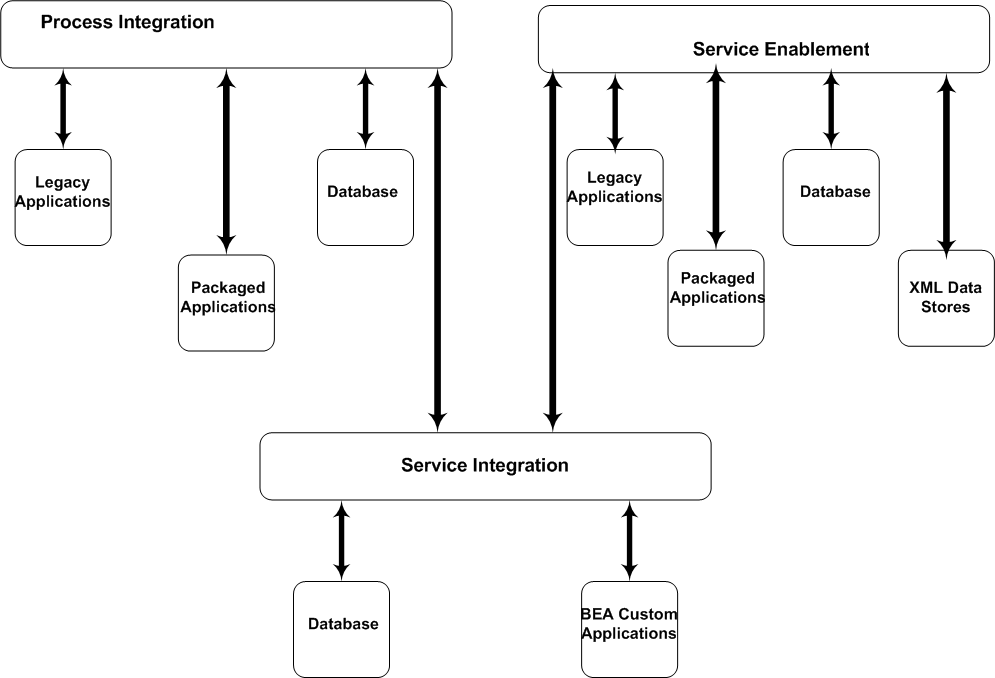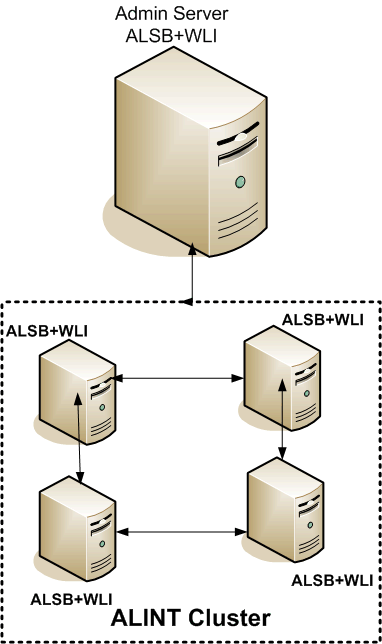







|
This document provides an overview of AquaLogic Integrator, explains installation of AquaLogic Integrator, configuring ALINT domains, and supported configuration details. AquaLogic Integrator will be referred to as ALINT in this document.
It is assumed that readers of this guide are familiar with the features of WLI and ALSB.
See WebLogic Integration and AquaLogic Service Bus documentation for information on WLI and ALSB.
From the menu on the left side of the screen, select Documentation for the appropriate release. The home page for the complete documentation set for the product and release you have selected is displayed.
AquaLogic Integrator (ALINT) is single solution bundle comprising ALSB 3.0 and WLI 10.2.
The document is organized as follows:
AquaLogic Integrator (ALINT) is a software bundle comprising WebLogic Integration (WLI) and AquaLogic Service Bus (ALSB).
ALINT offers the following capabilities of WLI and ALSB to manage reusable services in a dynamically changing environment:
In addition, ALINT offers developer productivity enhancements in an integrated environment. It ensures a consistent and scalable approach to SOA Integration through its integration with WorkSpace Studio, which is the unified assembly platform of BEA.
This chapter discusses the following topics:
The two major components of ALINT are:
WebLogic Integration Service Oriented Architecture (SOA) paradigm, used for service creation and enablement, building and exposing business processes as services. WLI business processes and composite applications can act as business services (service providers) or as service clients (service consumers).
WebLogic Integration provides the ability of seamlessly integrating business services within a system. WLI 10.2 is a unified solution for integrating business systems within an enterprise which reduces the cost of management and operations by providing highly reliable, stable, scalable, and mission critical integration solutions.
WebLogic Integration combines the divergent pieces of the business integration picture, including Enterprise Resource Planning (ERP), Customer Relationship Management (CRM), legacy applications, business users, supply chains, and trading partners, by providing a versatile development environment that delivers rapid business integration with simplified production and management.
For more information about WebLogic Integration, see the WebLogic Integration documents.
AquaLogic Service Bus (ALSB) is a configuration-based, policy driven Enterprise Service Bus (ESB). ALSB is a key product in the Service Infrastructure family of infrastructure software, targeted at the implementation, deployment and governance of Service Oriented Architecture (SOA).
AquaLogic Service Bus provides a Service Mediation layer between service provider and service receiver, enabling a loosely coupled architecture.
For more information about ALSB, see AquaLogic ServiceBus documentation.
AquaLogic Integrator has three key features —process integration, service integration, and service enablement. BEA AquaLogic Integrator delivers the ability to integrate, deploy, and manage process-driven services inside and outside the enterprise in a single solution.
Process Integration: ALINT makes it possible to design, deploy and manage automated processes that tightly integrate existing enterprise systems, cross-enterprise applications, business users and expose these business processes as Services. Users can leverage data or process logic from mainframes and other legacy data sources or from packaged and custom applications. BEA AquaLogic Integrator integrates existing enterprise systems, cross-enterprise applications, and decision makers for simple exception handling and approvals.
Service Integration: ALINT includes a stateless, high-performance intermediary built to handle the demands of an enterprise SOA. ALINT provides a configuration-driven layer to simplify connection, mediation and policy enforcement of disparate, heterogeneous services. It accelerates service publishing, service brokering, configuration and deployment, and simplifies management of shared services across the SOA and future-proofs the SOA from on-going service endpoint changes.
Service Enablement: ALINT makes it possible to build adaptable, service-oriented environments. WebServices are built on and includes BEA WebLogic Server; services, processes, and mediation all inherit the reliability, scalability, security, and extensibility of the world’s leading application server.
Figure 1-1 provides the concept of AquaLogic Integrator

Following are the advantages of using ALINT:
WLI and ALSB can be installed using one installer. The ALINT installation wizard provides both the WLI and ALSB options, and you can install both the products in the same BEA Home. For more information about installation, see Installing AquaLogic Integrator.
| Note: | You can install ALINT by using the individual product installers (WLI and ALSB). You need to install WLI, and then install ALSB, or vice-versa in the same BEA_HOME directory to be able to use ALINT functionality. |
ALINT provides the ability to deploy both WLI and ALSB applications on the same domain, reducing the maintenance overheads for the user. You need not create two different domains for WLI and ALSB.
WLI and ALSB co-exist on a common domain. For more information about creating and configuring a domain, see Creating a Domain. Figure 1-2 illustrates common domain concept.

The two new transports - SB Transport and JPD transport being introduced with ALINT, provides security context and transaction context from ALSB to WLI and vice-a-versa. For more information about Transports, see AquaLogic Service Bus documents.
ALINT provides a unified Integrated Development Environment (IDE) for WLI and ALSB on an Eclipse platform. This environment based on WebLogic Workshop, provides easy navigation between WLI and ALSB artifacts. You could create a JPD, and generate a WSDL in WLI, then switch to ALSB perspective, use the WSDL generated in WLI to create a Business Service or a Proxy Service. For more information, see Designing a Purchase Order Processing System by Using Aqualogic Integrator.
Installing AquaLogic Integrator describes how to install ALINT.


|